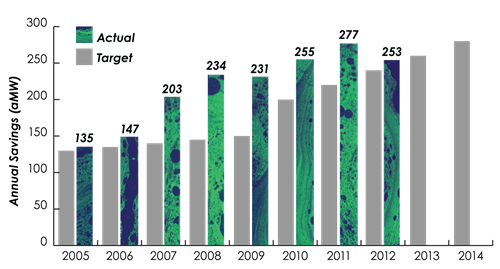Energy Efficiency Now the Northwest's Second Largest Resource, and Growing
For the eighth year in a row, energy efficiency improvements in 2012 surpassed the Council's annual target
- January 15, 2014
- John Harrison
The 2012 savings, reported at the Council's January meeting and based on a survey of utilities, are equal to the annual electricity use of about 170,000 Northwest homes and exceeded the target by about 5 percent.
“Once again, the region’s utilities, Bonneville Power Administration, Northwest Energy Efficiency Alliance, Energy Trust of Oregon, electricity consumers, and businesses that install energy efficiency worked together to exceed the Council’s ambitious annual target,” Council Chair Bill Bradbury said. “Efficiency continues to be a very low-cost, environmentally clean power resource. It is now the region’s second-largest power supply, behind only hydropower.”
The 2012 savings totaled 253 average megawatts. The target in the Council’s Northwest Power Plan was 240. The calculation of 2013 savings won’t be completed until next fall.

Northwest utilities, the Energy Trust of Oregon, and their partners have been acquiring energy efficiency resources since 1978. Annual savings from cumulative investments through 2012 stood at 5,300 average megawatts -- nearly equal to the average annual output of the six largest hydroelectric dams in the Northwest. That’s enough electricity to serve nearly the entire state of Oregon today. Over those 34 years, energy efficiency met nearly 60 percent of the new demand for power.
The average cost of the efficiency investments in 2012 was about 1.8 cents per kilowatt-hour, which is about four times less expensive than the cost of power from any type of new generating plant. In 2012, as in other recent years, commercial and industrial savings grew the most -- faster than residential, agricultural, and other areas.
Regional utilities, the Bonneville Power Administration, the Northwest Energy Efficiency Alliance and others that administer energy-efficiency programs reported their 2012 savings in 2013. The accomplishments were compiled by the Council and its Regional Technical Forum, an advisory committee established in 1999 to develop standards to verify and evaluate energy efficiency savings. The next report on annual efficiency improvements, for 2013, is expected to be completed by next fall.
The Northwest has relied on energy efficiency for longer and to a greater degree than most other regions of the United States. The total U.S. investment in improved energy efficiency in 2012 was just over $5.35 billion; Northwest investments totaled $375 million, or about 7 percent of the national total even though the Northwest represents just under 5 percent of the U.S. population. The per-person average expenditure on energy efficiency improvements in the Northwest was $28.02, nearly double the United States average of $16.17, according to the Council’s staff.
More information:
Northwest Energy Efficiency Achievements
BPA's Business Case for Conservation



